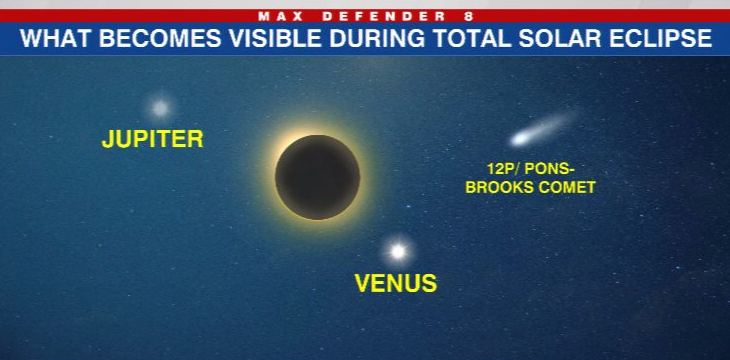TAMPA, Fla. (WFLA) —The star of the show (so to speak) during the total solar eclipse is clearing the corona of the sun, visible only because the moon has moved in between us and 100% of the sun’s light (for areas inside the path of totality.) But the darkness does give you a chance to see some planets, stars, and even possibly a once-in-71-years comet.
As we approach 100% totality, the first planet you may see is Venus. It will be bright and about 15° from the sun. It will be the brightest planet visible, and may be visible a little before, during, and a little after totality.
Hint: an easy way to use degrees to look for an object in the sky. If you close your fist and stretch it out straight, completely at arm’s length, the width of you fist is roughly 10 degrees.
The next, and most likely planet you will be able to see is Jupiter. It will not be visible until the 100% period of totality. It will be more faint than Venus, but should be visible to the naked eye. Jupiter will be about 30 degrees from the eclipsed sun.

Here’s a wildcard: a once-in-every-71-year-comet will be blazing by at the time. The12P/Pons-Brooks comet may peek out during totality. It is not guaranteed to be visible, but there is a small chance that it could flare up during that time and put on a show. This comet is a ball of dirt and ice, and somewhat routinely, chunks break off and cause bright flares of light. So often that the comet is nicknamed the “Devil Comet” or the “Millennium Falcon” because of dual flares that give the comet the appearance horns. If you get to see the comet, it will be about 25 degrees from the sun.
Experts say not to spend too much time looking for planets, stars, and the 12P/Pons-Brooks comet—they are visible at other times, whereas the eclipse itself will be roughly 20 years until the next occurrence in the continental U.S.

You should glance around though, it will look like twilight near the horizon for 360°. Also, listen up, crickets may begin chirping, birds may begin roosting behaviors, temporarily confusing it with the onset of nighttime.
The sudden onset of darkness is expected to lower the temperatures by about 10°, if it were wintertime with clear skies, the drop could be even more dramatic, around 20°.
The total eclipse will be visible from parts of the U.S. on April 8.






